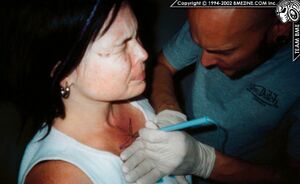Laser branding
Electrosurgery branding has been compared to using an arc welder for skin. It provides cautery by passing a high frequency electric current through the skin, and depending on the setting chosen, sparks can often be seen flying between the handpiece and the skin.
A common name for this type of branding is 'Hyfrecator branding', which takes its name from a popular brand of electrosurgical unit.
This form of branding is sometimes known by the misnomer 'laser branding' (a marketing term coined by Steve Haworth), even though nothing resembling a laser is ever actually used. Common medical lasers, as the type used in hair or tattoo removal are not appropriate for use in branding, and surgical laser-scalpels are prohibitively expensive and difficult to operate.
Types
There are two different types of electrosurgical units, monopolar and bipolar.
- In a bipolar unit, two electrodes are placed close together (either on a pair of forceps, or as part of a 'pen' type device. The current passes through the tissue between the electrodes, cauterizing it.
- In a monopolar unit, only one electrode is part of the handpiece, the other is placed beneath the patient to complete the circuit. Monopolar electrosurgery should be avoided on people who have pacemakers or other similar medical implants.
Benefits
An electrosurgery device offers the ability to exert very precise control over the depth and nature of tissue damage, allowing the experienced artist to build up a texturally diverse scar. As electric current is used rather than heat, there is no damage done to surrounding areas, so there is much less 'spreading' of the scar, and more intricate designs are possible than using either strike branding or electrocautery.

